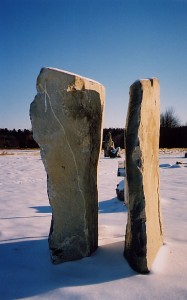Stonehenge West
Judith Young at the National Air and Space Museum

Judith Young wore a light, sheer robe, almost a wrap, that reached to within inches of the floor, over silky, swishy pajama-looking clothes. Very comfortable looking, the kind of new age-y clothes an academic wears so she can devote all her energy to thinking. Her long gray hair reached down her back to her waist. And she stayed in motion, from the podium to the screen and back again. She had a room full of eyes and ears riveted on her in the briefing room at the Smithsonian National Air and Space Museum on Tuesday, where she spoke about teaching astronomy outdoors with a time-tested circle of stones, or sunwheel.
While the most famous example of a sunwheel is England's Stonehenge, Young got her inspiration one summer on a visit to a ranch in Montana. There, a smaller, eroded sunwheel on former Blackfoot Indian territory lay near a cave. While no one's dated that sunwheel, artifacts found in the cave indicate human settlement in the area predating Stonehenge. Looks like Native Americans were in on the sunwheel act before the Europeans, she suggests.
"I don't think that the first solar calendars were kept for very complicated reasons," said Young. "Life was pretty hard thousands of years ago. It was worth noting that you had lived through a winter. Once they realized that there was a cycle, they may have started keeping track of how many winters they had survived."
Young returned to the University of Massachusetts at Amherst, where she teaches astronomy, and set about building her own sunwheel. After several false starts on a remote, undeveloped part of campus—the university wanted to know when the first human sacrifice would happen—Young got a National Science Foundation grant. This translated to serious granite monoliths, some weighing up to four and a half tons, delivered by a local quarry. Fifty-one tons of gravel later, each of the 16 new stones had its own base and a thick, flat foundation stone. Each monolith is secured with a long stainless steel spike anchor and is glued down for good measure, to keep the curious football players from trying to topple one post frat-party.
Since completing the project in the fall of 2000, Young has entertained school groups from second graders to grad students at the site, where they watch the sun rise and set over specific monoliths on the summer and winter solstices, and the autumnal and vernal equinoxes. She speaks of how the sunwheel, "the first unique stone circle calendar in the world on a university campus, enhances a sense of connection to the universe. It connects Earth and sky, sun and stone, matter and energy, science and art, past and present, and the observer and the horizon." Already, she says, it has inspired other wheels in eastern Massachusetts, California, and Colorado, Japan, Germany, The Netherlands, and Australia. Young has a log at the site for visitors to sign. Her website goes into detail on the history of sunwheels and how to use them.
"With 30,000 signatures," says Young, "it's now the second biggest tourist attraction in the region after the Emily Dickinson House."